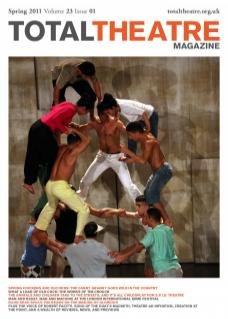What do theatre artists need to create work? When asked this question, one of the most frequent replies is: somewhere to make work that’s away from the demands of daily life, family commitments, administration and whatever else gets in the way. For makers: somewhere where materials can be assembled then left undisturbed, not put away and taken out endlessly, and big enough to create the necessary structures (set, props, large-scale puppets and animations); for actors, dancers and other movement practitioners, an empty space that’s clean and warm and available for a big long stretch of time, rather than rented by the hour.
Space and time, then, is what it boils down to. Enter the creation centre! It’s not a new idea: there have been creation centres of sorts in the UK for many years, usually artist-led ventures like Lanternhouse (set up by Welfare State International, as our Canny Granny documents in her column Home Truths, which this issue takes a not-too-reverent look at the subject of creation centres). And many other companies have created spaces for themselves to work in, often opening up those spaces to other artists and projects.
The Canny Granny also mentions Atelier 231 in France, a centre I had the pleasure of working in last month (January 2010). There are a whole bunch of French creation centres dotted around the country and varying enormously in size/style/ethos, with the common factor that they were set up to provide space (and time, as artists are invited to come and work in residence) for artists making street arts, site-specific theatre, and other forms of work for which it is difficult to find spaces to create as they, for the most part, operate outside of the regular theatre ‘built venue’ network and often involve large and/or cumbersome bits of kit.
There has been talk for years – decades, even – about UK initiatives for street arts and creation centres, and the big news at the moment is that what is being billed as ‘Britain’s first French style creation centre’ – Slip 6 in Kent, still in a process of development… watch this space as it is a subject we will be returning to throughout 2011.
Meanwhile, there is also a drive from venues to investigate the ‘creation centre’ idea – with Lanternhouse’s clean, new, purpose-built building being more the aim than the big old grimy warehouse model. In this issue, Miriam King (who was herself a supported artist of the venue) documents the development of Hampshire venue The Point’s new creation centre and supported artists scheme.
Total Theatre Magazine is of course always interested in how artists go about making their work, and in this issue you will find an artist’s diary by Rajni Shah, Glory Days, on the creation of her new show Glorious, which will premiere at the Barbican as part of SPILL, April 2011. In another of our features, To Infinity and Beyond, Theatre Ad Infinitum’s co-artistic directors interview each other.
Our new regular feature, The Works, has Tim Crouch as its subject; Being There gives us a threeway look at S.P.I.D. Theatre’s Childsplay; and our Voices candidate is theatre-maker and director of SPILL, Robert Pacitti.
The Reviews section includes the new 1927 show at BAC, a multi-voiced reflection on family-friendly theatre, and two special reports on the London International Mime Festival 2011.
Plenty to put a spring in your step, then!

